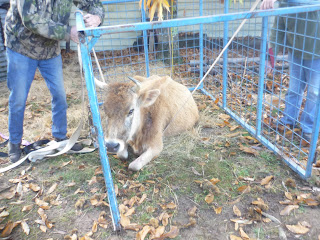Too many roosters. This tends to happen when breeding your own chooks but this time the excess was due to bringing in new blood - two young roosters acquired through the Snowy Mountains Poultry exchange. A third excess rooster was an old Barnevelder due to be replaced by his virile and beautiful son!
I am a beginner at chook butchery but I have found that using a killing cone make the dispatching easier - as long as the knife in use is sharp enough. The blood can drip out and the twitching stop without having to be near the carcass.
After this the bird is hung up in the shed before being dunked in very hot water. I have an old copper that does a great job at heating up water quickly and so a few seconds dip and the feathers are ready to come out quicker and easier. The feathers smell wet and can tend to stick to your hand or glove but it is an efficient way to pluck.
After plucking I cut off the wings at the elbow, the tail, the head and the lower legs before gutting. Again I need a sharper knife but the process is gradually getting easier.
Once the three roosters were processed I placed them in ice cold water for a couple of hours before putting them in the bottom of the fridge for at least 48 hours. This is supposed to remove at least 80% of the rigour and help make the bird more tender. The first chooks I butchered were placed straight in the freezer and proved almost inedibly tough. This time I hope it works better.
The replacement roosters needed to be introduced to their pens of hens. First however I needed to clip one wing to keep them grounded. The only feathers that need to be cut are the eight primary ones - at the point where the secondary feathers start. I use a stout pair of scissors that I keep in the shed. I think they were once dressmakers scissors.
The primary feather removed.
The primary feathers on the other side.














